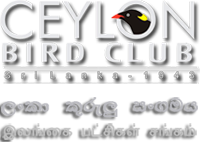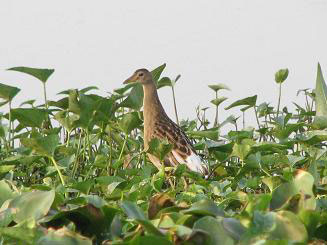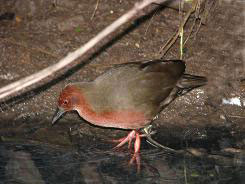


Thushara Senanayake - CBCN April 2009 page 68 to 71
 The Lunawa Lagoon is located in the north-west part of Moratuwa. It is a perennial water body that opens seasonally to the ocean at Angulana. The lagoon and its banks are rich in biodiversity for a site in a densely populated suburb of Colombo. Situated about 20 km away from the centre of the capital, it is proving to be increasingly attractive to bird observers.
The Lunawa Lagoon is located in the north-west part of Moratuwa. It is a perennial water body that opens seasonally to the ocean at Angulana. The lagoon and its banks are rich in biodiversity for a site in a densely populated suburb of Colombo. Situated about 20 km away from the centre of the capital, it is proving to be increasingly attractive to bird observers.
The bird life at the site has been studied by me since August 2007. Presented here is a report on its diversity for the 18 months from that time to February 2009. Further details have been published in the monthly Ceylon Bird Club Notes. The frequency of visits to the site during the period was about eight per month on average.
At the time on the banks all around were grass, low shrubs, reeds, many Kirala Sonneratia caseolaris and a few other larger trees. Only at very few places, though, was the vegetation dense.
A total of 75 species of birds was recorded in the lagoon and within a range of 50 metres outward from its bank. Of resident species a few were not found during certain months when the water level was low. Certain species of migrant birds, in contrast, were recorded only during such times. Among the resident species some were observed breeding in certain months and others throughout the year.
The endemic Ceylon Small Barbet Megalaima rubricapillus occurred through the year.
Resident waterbirds recorded across the year were: Spot-billed Pelican Pelicanus philippensis, Little Cormorant Phalacrocorax niger, Grey Heron Ardea cinerea, Purple Heron A. purpurea, Little Egret Egretta gazetta, Large Egret E. alba, Median Egret E. intermedia, Indian Pond Heron Ardeola grayii, White-breasted Waterhen Amaurornis phoenicurus, Purple Coot Porphyrio [porphyrio] poliocephalus, Pheasant-tailed Jacana Hydro-phasianus chirurgus and Red-wattled Lapwing Vanellus indicus.
Of other resident waterbirds Little Grebe Tachybaptus ruficollis and Lesser Whistling Teal Dendrocygna javanica were not noted from the end of February to the end of April 2008. They were back when the water had risen with the monsoon rains in May. Unexpected was the disappear-ance of Cattle Egret Bubulcus ibis during certain months, including March and April, from the lagoon although they were abundant at other places in Moratuwa throughout the year. Indian Shag Phalacrocoraxfuscicollis
was noted in November 2008 for the first time and occured until the end of the study period.
Little Green Heron Butorides striatus, Yellow Bittern Ixobrychus sin-ensis and Black Bittern I. flavicollis were recorded only from September to April (which is during the winter migrant period). The literature states that the numbers of the latter two species are augmented by winter visitors. These observations suggest the possibility of internal migration of these two species and internal or external migration of the Little Green Heron.
Common Moorhen Gallinula chloropus was recorded for the first time in September 2008. This is an indicator that the site had become more favourable for birds, especially waterbirds.
A rare record was two Ruddy Crakes Porzana fusca. I spotted this elegant species for the first time in November 2008 and then one or two of them until the end of the study period. They foraged freely in the banks of the lagoon. Similarly, a pair of Watercock Gallicrex cinneria and a Stone-Curlew Burhinus oedicnemus began appearing since January 2009.
Of the migrant waterbirds Common Sandpiper Actitis hypoleucos was recorded as early as September and then from October onwards. Gull-billed Tern Gelochelidon nilotica, Common Tern Sterna hirundo, which is partly resident in Sri Lanka, Whiskered Tern Chlidonias hybridus and White-winged Black Tern C. leucopterus were seen at the site, the Common and Whiskered Terns being numerous.
Following the ebb in the water level after January the migrants Lesser Sand Plover Charadrius mongolus, Marsh Sandpiper Tringa stagnatilis, Wood Sandpiper T. glareola, and the Black-winged Stilt Himantopus him-antopus, which migrates both externally and from the dry zone of Sri Lanka, were recorded in the lagoon, as it was now easy for them to probe the mud, sand or silt in it.
The only two raptors recorded during the study were Brahminy Kite Haliastur indus and Shikra Accipiter badius. They occurred throughout the year.
Resident birds recorded in addition to the above were: Spotted Dove Streptopelia chinensis, Rose-ringed Parakeet Psittacula krameri, Common Coucal Centropus sinensis, Indian Koel Eudynamys scolopacea, Brown Hawk-Owl Ninox scutulata, Palm Swift Cypsiurus balasiensis, Alpine Swift Tachymarptis melba, House Swift Apus affinis, Common Kingfisher Alcedo atthis, White-breasted Kingfisher Halcyon smyrnensis, Pied Kingfisher Cerylerudis, Indian Roller Coraciasbenghalensis, Brown-headed Barbet
Megalaima zeylanica, Red-backed Woodpecker Dinopium benghalense psarodes, Red-vented Bulbul Pycnonotus cafer, Magpie Robin Copsychus saularis, Black Robin Saxicoloides fulicatus, Southern Common Babbler Turdoides affinis, Streaked Fantail Warbler Cisticola juncidis, White-browed Prinia Prinia inornatis, Common Tailorbird Orthotomus sutorius, Tickell's Flowerpecker Dicaeum erythrorhynchos, Purple-rumped Sunbird Leptocoma zeylonica, Loten's Sunbird Cynniris lotenius, White-backed Munia Lonchura striata, Spotted Munia L. punctulata, Common Mynah Acridotheres tristis, Black-headed Oriole Oriolus xanthornus, White-bellied Drongo Dicrurus caerulescens, House Crow Corvus splendens and Jungle Crow C. macrorhynchos.
A Paradise Flycatcher Terpsiphone paradisi was seen which was chestnut in colour. Observation of further detail to subspecies was not pos-sible: thus it may have migrated either from India or the dry zone of Sri Lanka.
Of other migrant birds Blue-tailed Bee-eater Merops philippinus was the first to be recorded: this was in September. Eurasian Common Swal-low Hirundo rustica rustica, Asian Common Swallow H. r. gutteralis, Grey Wagtail Motacilla cinerea, Brown Shrike Lanius cristatus cristatus, Brown Flycatcher Muscicapa dauurica and Blyth's Reed Warbler Acrocephalus dumetorum were other migrants recorded at the site. It can be surmised that they occur in it regularly.
The Lunawa Lagoon performs an important role in the area as a breed-ing site for many species of resident birds. White-browed Prinia bred here throughout the year. I discovered their nests among the rushes at the banks of the lagoon all the year round and saw many fledglings being fed by their parents among this vegetation.
Nests of Rose-ringed Parakeet, Brown-headed Barbet, White-breasted Kingfisher, Red-vented Bulbul, Magpie Robin, Common Mynah, White-bellied Drongo and House Crow were also found.
 Although I observed a Brahminy Kite carrying nesting material I could not locate its nest. In fact, it dropped the material when it realized that I was watching it and changed direction apparently to deceive me, 2-3 times. Later I learnt from another observer that there was a nest of this raptor on a very tall Kottamba Terminalia catappa tree, which was later bulldozed in the name of "development".
Although I observed a Brahminy Kite carrying nesting material I could not locate its nest. In fact, it dropped the material when it realized that I was watching it and changed direction apparently to deceive me, 2-3 times. Later I learnt from another observer that there was a nest of this raptor on a very tall Kottamba Terminalia catappa tree, which was later bulldozed in the name of "development".
Other birds which depended on the surroundings of the lagoon to collect nesting material observed by me were: Spotted Dove, Black Robin, Southern Common Babbler, Purple-rumped Sunbird, Loten's Sun-
bird, White-backed Munia and Spotted Munia. They carried the material from the site from time to time.
Common Tailorbird and Tickell's Flowerpecker were seen taking insects in their beaks, to feed young, indicating that they were nesting nearby.
The young of Little Grebe, Spot-billed Pelican, Grey Heron, Purple Heron, White-breasted Waterhen, Purple Coot, Red-wattled Lapwing, Little Green Heron, Shikra and Common Coucal were recorded at the site many times. It is thus probable that they were breeding close by.
The following species were observed assuming their breeding plumage during the early part of the year: Little Egret, Large Egret, Median Egret, Cattle Egret, Indian Pond Heron and Pheasant-tailed Jacana.
Acknowledgements
I thank my wife Mary Ann and children Mahimi and Devdun for tolerating my absences away at the site, and for accompanying me to it on and off thus giving my study a boost; Kithsiri Gunawardena, Udaya Sirivardana, Pathmanath Samaraweera, Deepal Warakagoda and Jagath Gunawardana for reading and helping me improve this paper; Kithsiri, "Dr Sam" and Deepal for sharing their knowledge and experience when they accom-panied me to the site; Kithsiri again for donating to me a camera with which I took many photographs I could examine at home to identify cer-tain birds and observe finer detail to gather scientific data; Tara Wik-ramanayake, Niran Caldera and Thilo Hoffmann for providing me with optical equipment; and Hirantha Weerasinghe for information on the Brahminy Kite nest.
References
de Silva Wijeyeratne, G, Warakagoda, D & de Zylva T.S.U (2000) A Pho-tographic Guide to Birds of Sri Lanka. New Holland Publishing (UK) Ltd, London.
Harrison, J & Worfolk, T (1999) A Field Guide to the Birds of Sri Lanka. Oxford University Press, Oxford.
Rasmussen P.C & Anderton J.C (2005). Birds of South Asia: the Ripley Guide. Vols.1,2. Smithsonian Institution & Lynx Edicions, Washington DC and Barcelona.
Senanayake, T (2008, 2009) In: Ceylon Bird Club Notes.
Warakagoda, D & Hettige, U (2008) CD-ROM: Birds of Sri Lanka: Vocalization and Image Guide Vol.1. Bird and Wildlife Shop, Colombo.